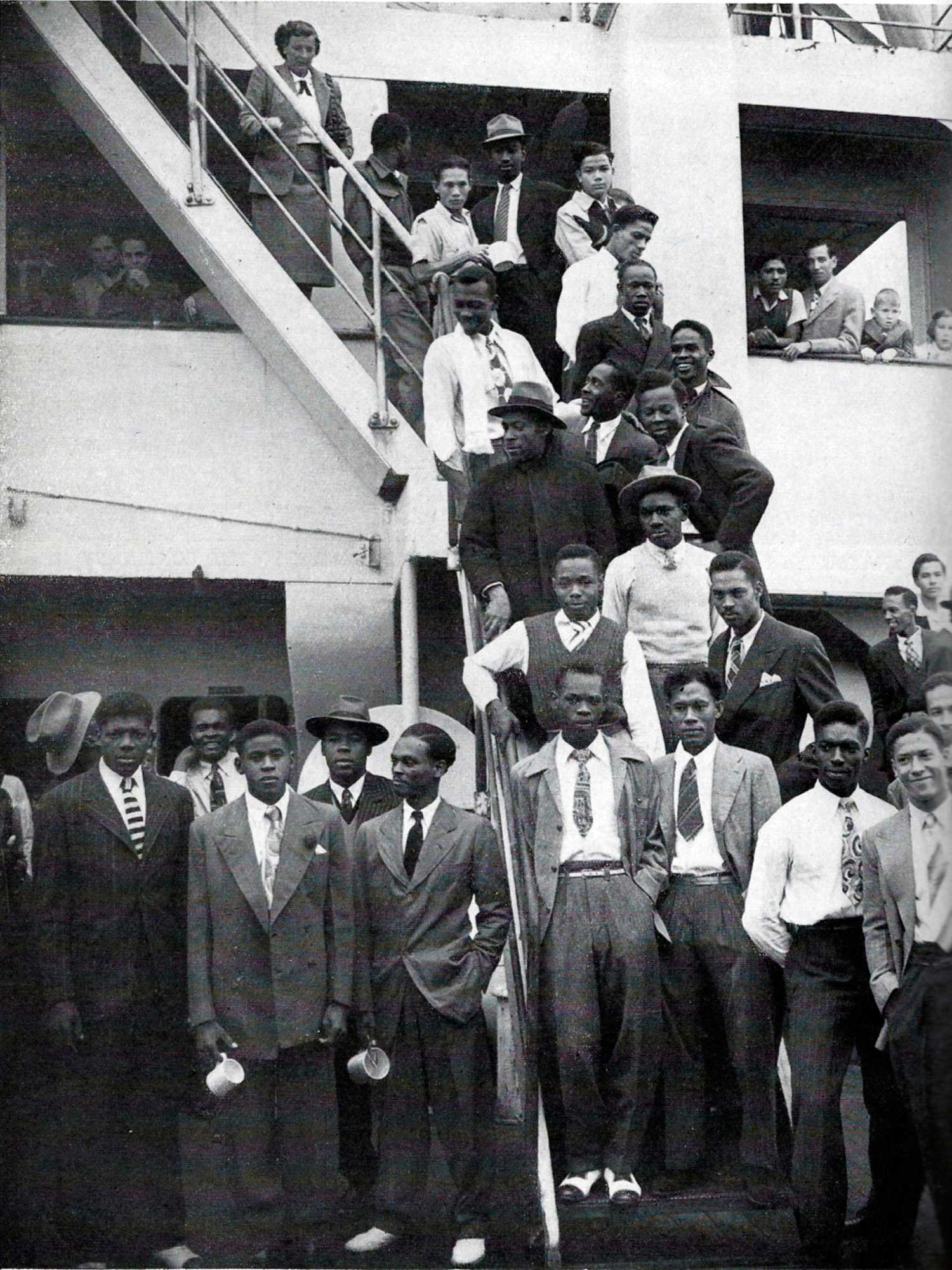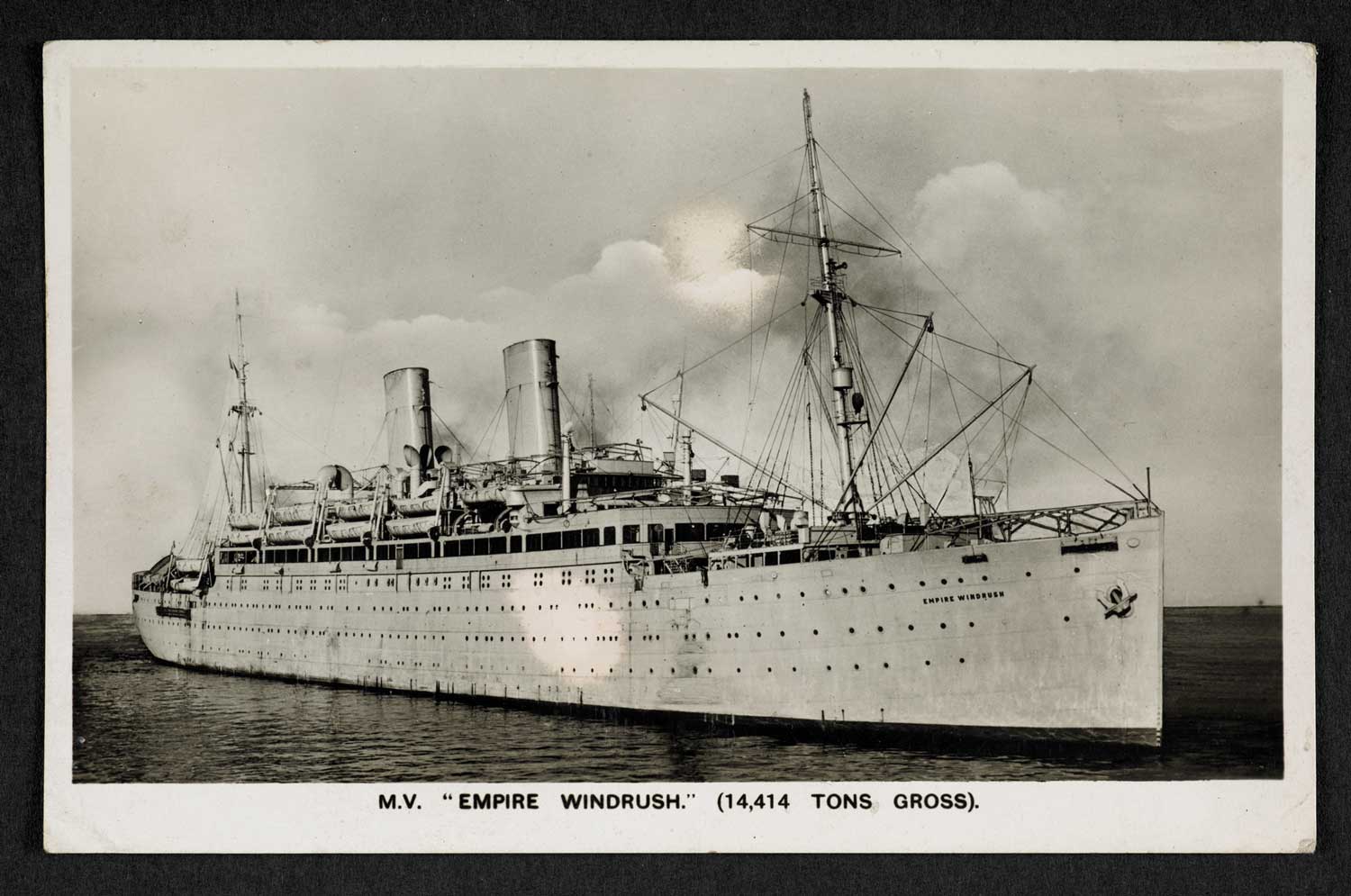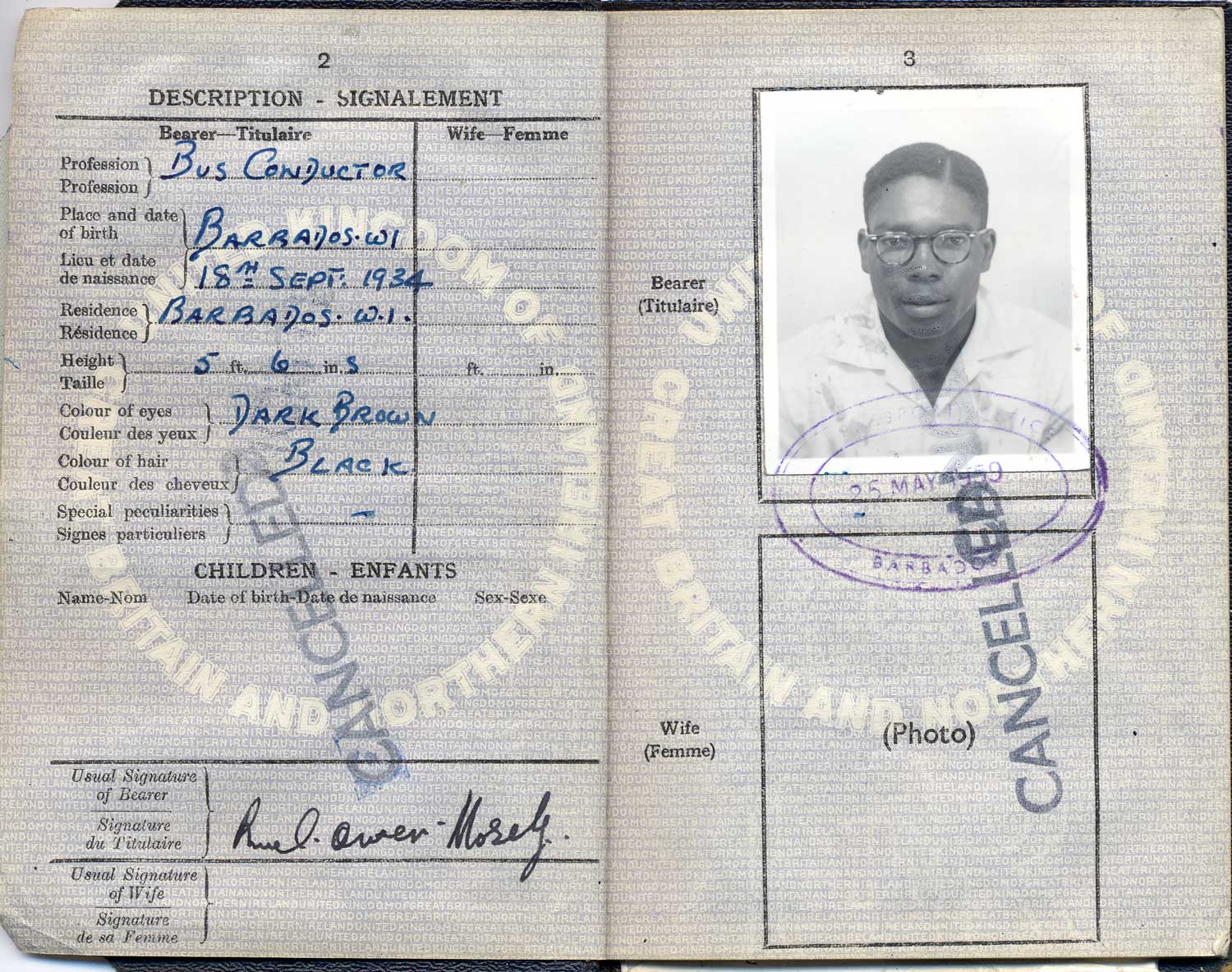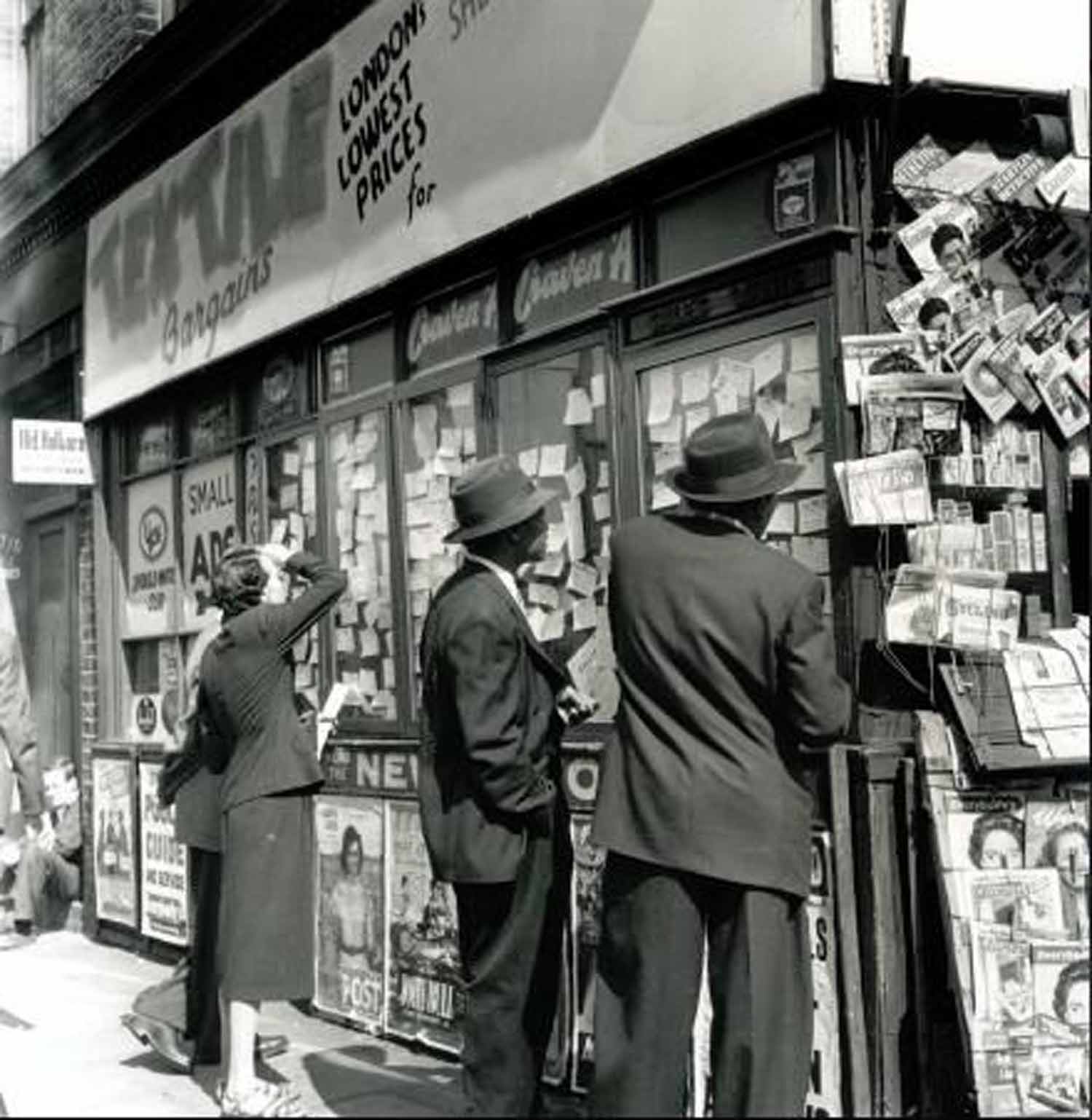By Ship and Plane
I did not dare to dream that it would one day be I that would go to England. It would one day be I that would sail on a ship as big as a world and feel the sun's heat on my face gradually change from roasting to caressing.
- Small Island, Andrea Levy
Migrants initially travelled to the UK by ship. They travelled on a British/Colonial passport with which they were issued in their home country in the Caribbean, and the journey could last as much as 4 weeks. The most notable ship to arrive in the UK carrying migrants from the Caribbean was the MV Empire Windrush, which left Jamaica on May 24, 1948 and arrived at Tilbury dock on June 22, 1948.

Jamaicans disembarking at Tilbury, WIC Circular 1948
According to a passenger on the ship, the journey from Jamaica to the UK took about 22 days, which to them was a long journey. They went to Tampico (Mexico), spent about 3 or 4 days there, passed by Havana, then on to Bermuda, where they spent another 4 days. The ‘Windrush’ became the iconic image of migration and has given its name to the first generation of Caribbean migrants.
Prior to the MV Empire Windrush’s arrival, two other ships landed carrying a much smaller number of Caribbean migrants – while they never received similar fanfare or public recognition - the SS Ormonde, which arrived in March 1947; and the SS Almanzora, which arrived at the Southampton dock on December 21, 1947 - 6 months before Windrush, were equally important to this pattern of migration.
Following the 1948 arrival of the Windrush other ships such as the SS Orbita, the SS Reina del Pacifico, the SS Sorento and the SS Georgic to name a few also played their part in this history. The SS Auriga similarly left Jamaica on August 2, 1955, carrying approximately 1,100 passengers, and was followed about two days later by the SS Castle Verde, which carried another full shipload.
At first the number of migrants from the Caribbean was relatively low, but by 1952 the numbers picked up. Throughout the 1950s there were many ships sailing from the Caribbean to Britain. Some of the lines even docked in Italy and migrants had to travel by train to the UK. By 1960, migrants started travelling by plane to the UK, thus making the journey much shorter and easier. Between 1948 and 1964 an estimated 300,000 West Indians had come to Britain, a number which exceeded the previous large-scale migrations to Panama, the USA and other countries in the Caribbean where an estimated 200,000 – 250,000 moved.
Watch 'Empire Windrush' Ship Arrives In UK Carrying Jamaican Immigrants 1948

Andrea Levy Postcard of Empire Windrush - Courtesy of the estate of Andrea Levy

Passport © TfL from the London Transport Museum collection
Going Ashore
Do not put on your best clothes for landing.
- Going to Britain, 1961
Many of the passengers on the MV Empire Windrush were former servicemen hoping to secure employment in the UK, or to re-enlist. Others were coming to England for the first time. They have told of the varied emotions felt on board, including anticipation, optimism, hope and regret. A number of them were anxious about the unfamiliar conditions and this apprehension was laced mainly with fear that the authorities would turn them back when they arrived.
Given the low prices that travellers paid, the cabins they got were typically shared with other passengers. For those who paid even lower prices, the conditions were even more cramped, and passengers had to share with strangers. Some of them experienced seasickness for the majority of the journey making their experience quite miserable. The food served was also unfamiliar to many migrants and therefore some of them remained hungry for the majority of the journey.
There was a media buzz around the arrival of the Windrush, which meant the passengers were greeted with a lot of attention on arrival. Many, however, went on to experience ignorance and hostility from those living in the receiving country who viewed the migrants as unwelcome threats to the stability of the UK, not least by the government of the day.
What Shall I Take to England
Jus a pack dem bag an baggage
An turn history upside dung!
- Colonisation in Reverse, Louise Bennett
Migrants packed their luggage based on the idea that they were going to spend no more than five years in Britain. Some people had never travelled abroad before, especially to a country with a much different climate.
Some of the clothing that the West Indians brought with them were second-hand overcoats to help combat the cold climate; others had pullovers or “lumberjacks”, as they were called in Barbados, as well as old-style “Trilby” felt hats imported from England, common throughout the Caribbean. Other favourites were the 1940s “zoot suit” fashion, adopted from American popular culture. Many of the women also had special outfits made for embarkation.
Mainly though, the clothes that were packed by these migrants were items for everyday life in the tropics and not items that could withstand the cold climate of Britain. Some travellers packed as little as a rucksack which held the items they considered necessary for the journey, while others packed their “grip,” a small suitcase that most West Indians packed when they were going on a trip. Each “grip” also held valuable belongings that many West Indians brought from home to remind them of the Caribbean.
The World Where Everything Was Possible
Belief in an ideal dies hard. I had believed in an ideal for all the twenty-eight years of my life – the ideal of the British way of life.
- To Sir, With Love, E.R. Braithwaite
Many West Indian migrants experienced a rude awakening on arrival in 1948.
In addition to the drastic change in climate for which they were woefully unprepared, many of the inner cities were still devastated by the wartime bombing and there was a critical shortage of housing for everybody. Even later migrants commented on the vast difference in environment, noting that when they saw the chimneys on the houses they thought they were factories. The pristine surroundings they were expecting had been replaced with dirty buildings and streets. The cultural differences were so vast, and expectations so shattered, that some migrants were not sure that they had arrived in the right place.

© TfL from the London Transport Museum collection
For those who had arrived after receiving letters that gave them such positive and beautiful impressions of the UK, there was shock and disappointment at the challenges they faced in finding employment and accommodation, not to mention the persistent racism they endured. Furthermore, some were disgusted with the living conditions that they found their fellow West Indians in, and considered the UK to be devoid of happiness.
These aspects of life in the UK were often not reported, and it was agreed by several migrants that the letters received back home did not portray the reality of what West Indians had actually braved; instead, the letters continued to paint a false picture of the UK in order not to upset loved ones left behind.





